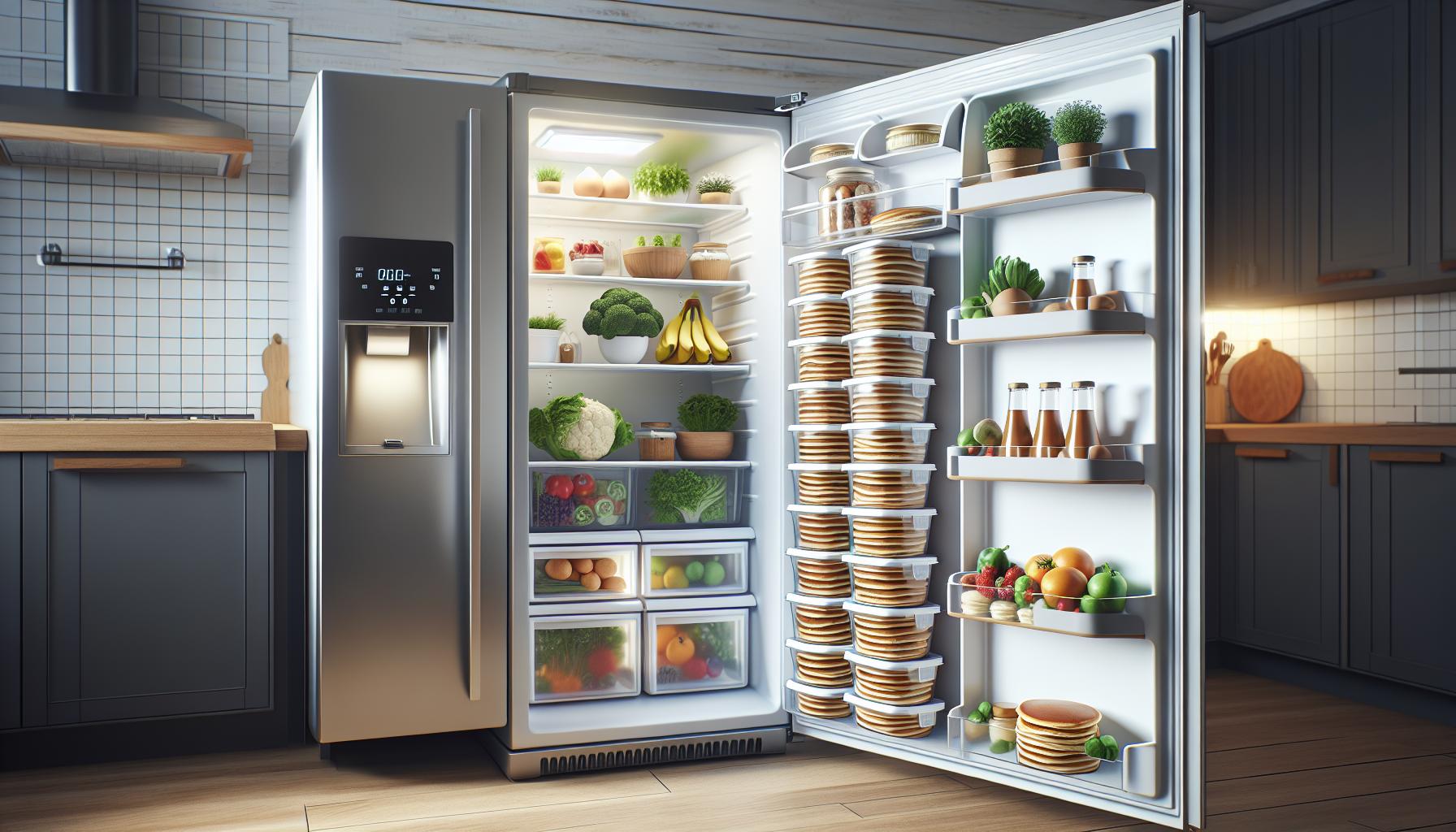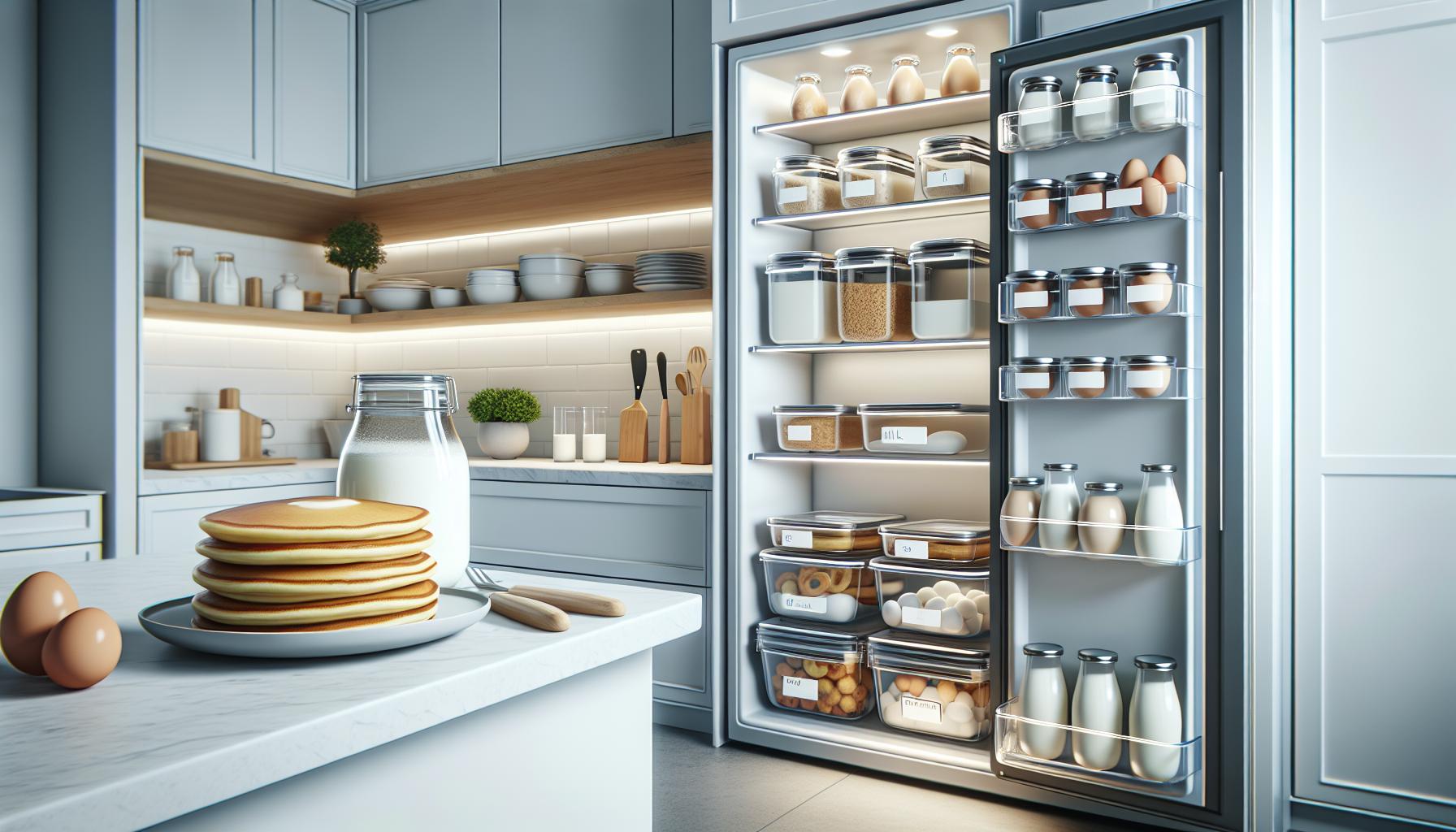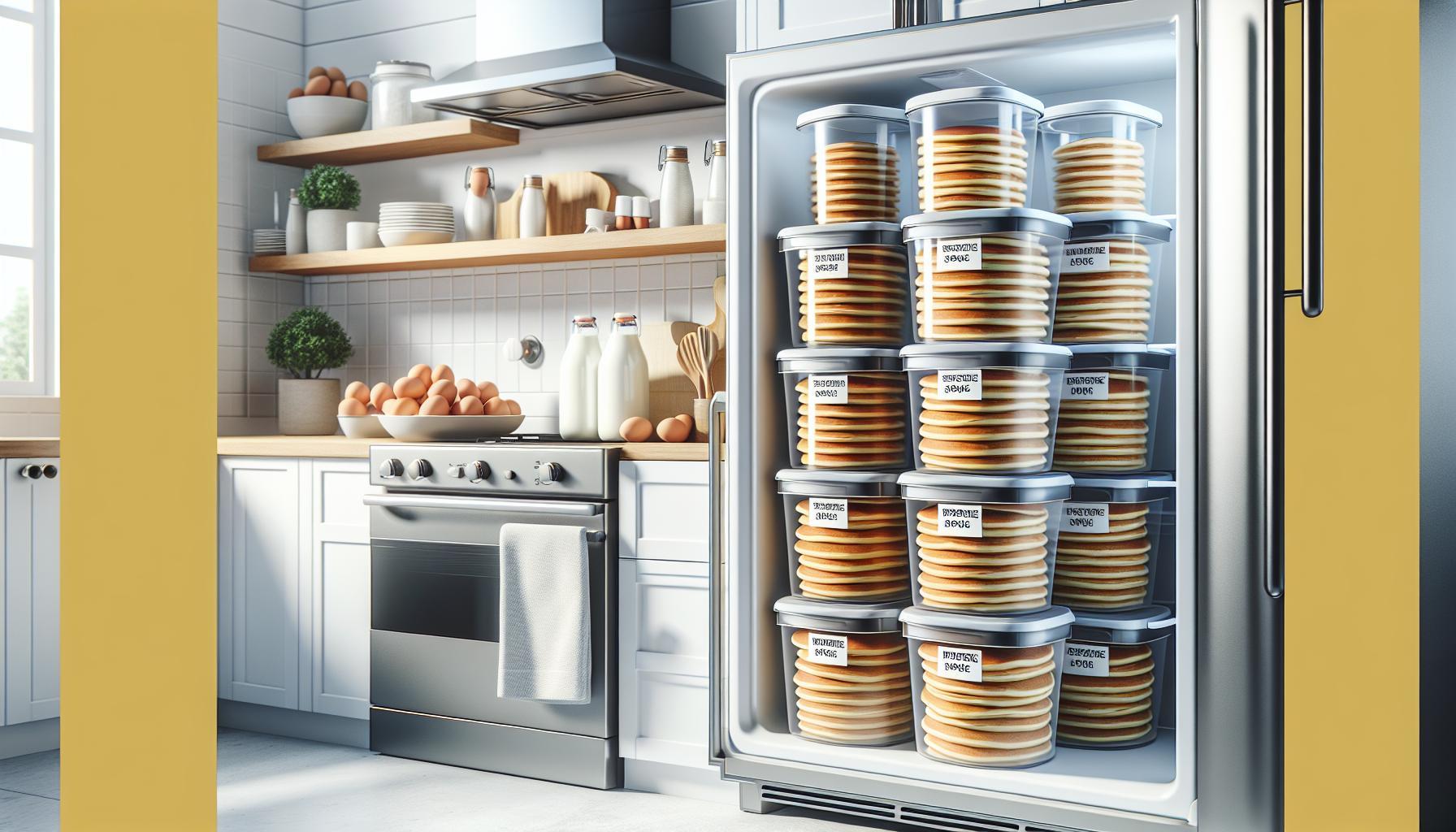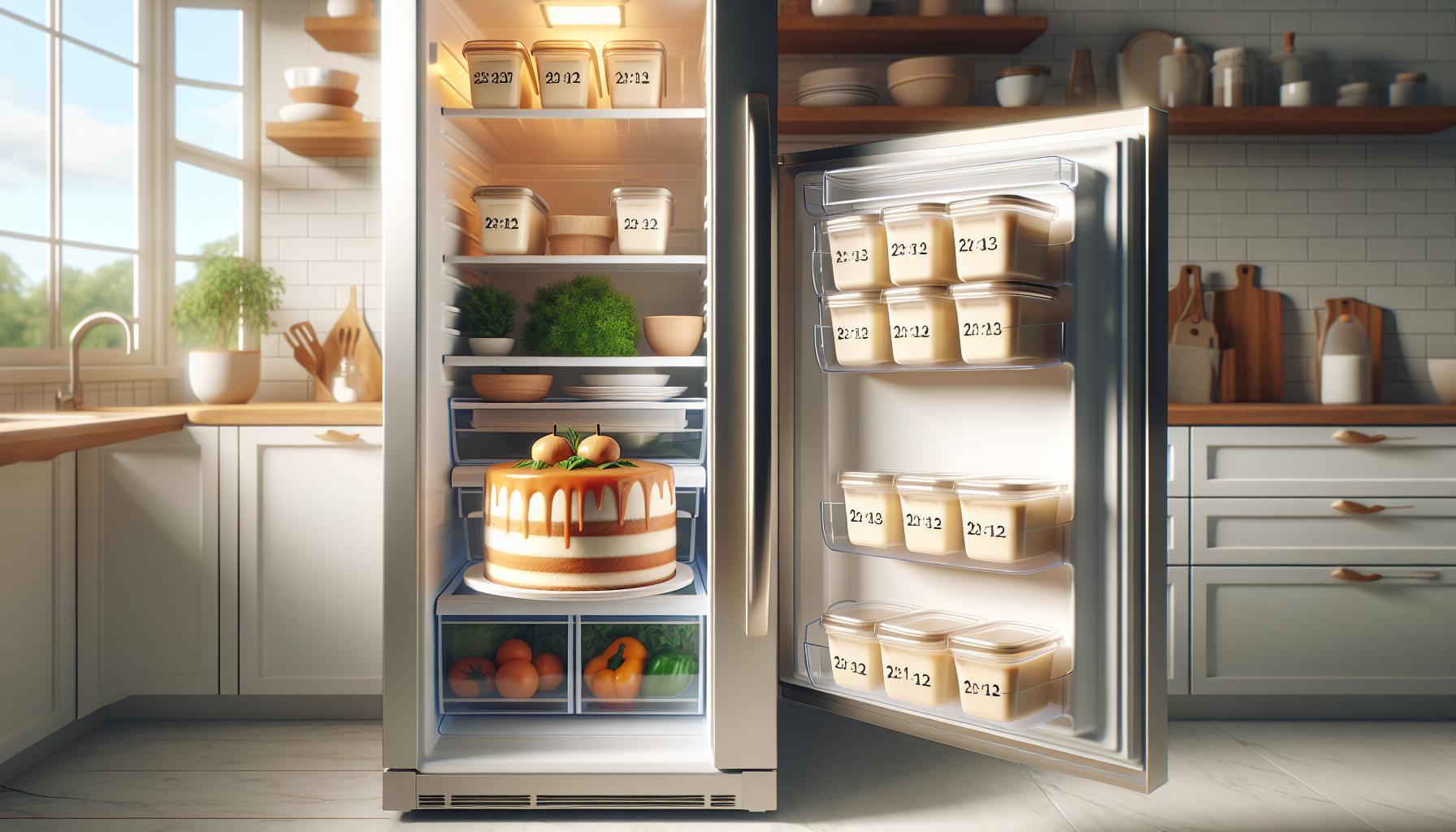Pancakes are a beloved breakfast staple, but what happens when you have leftover fluffy stacks? Understanding how long pancakes last in the fridge is crucial for both food safety and enjoyment. Properly stored, pancakes can maintain their deliciousness for several days, allowing you to savor every bite without waste.
Imagine the convenience of whipping up a batch of pancakes, only to discover you can enjoy them for breakfast or a quick snack later in the week. However, many people are unsure about how to store them effectively and how long they can keep. This guide will provide you with essential storage guidelines and tips to help you maximize the lifespan of your pancakes while ensuring they remain safe to eat. Ready to keep those pancakes tasting just as good as the day they were made? Let’s dive in!
How Long Can You Keep Pancakes in the Fridge?
Pancakes are a delightful breakfast staple, but knowing how long they can last in the fridge can help you prevent waste and enjoy your fluffy stacks longer. Typically, freshly made pancakes can be stored in the refrigerator for up to three to four days. After this period, their quality may deteriorate, leading to changes in texture and flavor.
To properly store pancakes, it’s essential to let them cool completely before placing them in an airtight container or wrapping them tightly with plastic wrap. This method helps to keep moisture in and prevents drying out. If you find yourself with a significant number of leftovers, consider placing parchment paper between the pancakes to keep them from sticking together, making it easier to separate them when you’re ready to reheat.
Remember, while pancakes stored in the fridge can last a few days, always check for signs of spoilage before consuming. If you notice any discoloration, off smells, or changes in texture, it’s best to discard them. Prioritizing food safety will ensure you enjoy your pancakes at their best!
The Science Behind Pancake Storage
Storing pancakes is not just about throwing them into the fridge; it’s a science that helps maintain their delightful fluffiness and taste. Pancakes are primarily made of flour, eggs, and milk, all of which are prone to spoilage if not stored properly. The key to keeping them fresh lies in understanding how the ingredients interact with storage environments, including temperature and moisture levels.
When pancakes are left out, they are exposed to air and bacteria, which can cause them to dry out or develop mold. Refrigeration slows down the growth of these microorganisms, allowing pancakes to last longer-up to three to four days in the fridge. However, the refrigeration process can also lead to moisture loss, causing pancakes to become dense and tough. To combat this, it’s crucial to ensure pancakes cool completely before refrigeration. Once cooled, they should be placed in an airtight container, which traps moisture and creates a barrier against air.
Using parchment paper between stacked pancakes can dramatically enhance storage quality by reducing stickiness and preserving texture when it’s time to reheat. Additionally, the temperature of your fridge plays a role; ideally, it should be set below 40°F (4°C). This environment not only maintains the integrity of the pancakes but also extends shelf life and ensures safety against foodborne illnesses. Just as importantly, always inspect leftover pancakes for signs of spoilage like unusual smells, discoloration, or an off texture before consumption. Being proactive about these details can turn leftover pancakes into delightful morning treats rather than a wasted meal.
Best Practices for Storing Pancakes
To truly enjoy pancakes beyond their initial serving, implementing proper storage techniques is essential. The key to preserving the light and fluffy texture of pancakes lies not only in how they are stored but also in the environment in which they are kept. Here are some effective strategies to keep your pancakes fresh and delicious for as long as possible.
Firstly, always allow your pancakes to cool completely before storing them. This step is crucial, as placing warm pancakes directly into an airtight container can create condensation, leading to sogginess. Once cooled, stack pancakes with sheets of parchment paper in between to prevent sticking and preserve texture. This method helps maintain the integrity of each pancake, enabling them to reheat beautifully without turning into a dense mass.
Ensure that the pancakes are stored in a clean, airtight container. This minimizes air exposure, significantly reducing the risk of drying out or absorbing other odors in the refrigerator. For optimal results, make sure your refrigerator is set to a temperature below 40°F (4°C). This temperature range not only helps extend the lifespan of the pancakes-allowing them to stay fresh for up to three to four days-but also ensures food safety by slowing bacterial growth.
If you’re planning on storing pancakes for an extended period, consider freezing them. Place the stacked pancakes in a freezer-safe bag or container, ensuring you remove as much air as possible before sealing. Frozen pancakes can last up to three months without significant loss of quality. When you’re ready to enjoy them, simply reheat directly from the freezer for a quick and satisfying meal. By adhering to these best practices, you can enjoy your fluffy stacks even days after they’ve been made, turning any leftover pancakes into a convenient and delicious option for future breakfasts.
Freezing Pancakes for Longer Freshness
If you’re looking to enjoy pancakes beyond brunch, freezing them is a fantastic solution that preserves both flavor and texture. Freezing is not merely about longevity; it’s also about maintaining that fluffy consistency that makes pancakes irresistible. When properly frozen, pancakes can last for up to three months without significant loss of quality.
To begin, allow your pancakes to cool completely after cooking. This step is crucial because placing warm pancakes into a freezer bag can cause moisture buildup and lead to freezer burn, ultimately affecting the texture. Once your pancakes are cool, stack them with sheets of parchment paper in between each one. This will prevent them from sticking together when frozen, making it easy to retrieve just the amount you need later.
Next, place the stacked pancakes into a freezer-safe bag or container. It’s essential to remove as much air as possible to minimize the risk of freezer burn, which can compromise quality. Label the bag with the date so you can keep track of how long they’ve been stored. When you’re ready for a pancake feast, don’t worry about thawing; you can reheat them directly from the freezer either in the microwave or on a skillet. This makes for a quick and satisfying meal option, perfect for busy mornings or spontaneous breakfast cravings.
By embracing these freezing techniques, you can enjoy the delightful experience of homemade pancakes anytime, turning your leftovers into a convenient treat that’s always at your fingertips.
Signs Your Pancakes Have Spoiled
Pancakes are a beloved breakfast staple, but their fluffy goodness doesn’t last forever. Knowing when pancakes have spoiled is essential to ensure food safety and prevent unpleasant surprises during mealtime. Spoiled pancakes don’t always present clear hazards but can lead to potential foodborne illnesses. Paying attention to the signs of spoilage will help you enjoy your pancakes safely and deliciously.
One of the most noticeable indicators of spoiled pancakes is the presence of mold. If you see any fuzzy patches or discoloration on the surface, it’s a clear sign they should be discarded immediately. Moreover, pancakes that have developed an off-odor-a sour or unpleasant smell-are no longer fresh and should not be consumed. Keep in mind that when pancakes are left in the fridge for too long, they can take on a stale texture. If they feel excessively dry or hard, it’s a strong indication that their quality has deteriorated.
Another factor to consider is the duration of storage. Typically, pancakes can be safely stored in the refrigerator for about 3 to 5 days. If you’re unsure about how long they’ve been sitting in your fridge, it’s better to err on the side of caution. Even if there are no visible signs of spoilage, consuming food that has been stored past its recommended time frame can pose health risks.
When reheating pancakes, be aware that if they don’t retain their usual fluffiness after warming, this may also suggest they are past their prime. They should feel soft and spongy, much like when they were freshly made. In summary, by observing these vital signs of spoilage-mold growth, off-odors, excessive hardness, and storage time-you can make informed decisions that keep your meals safe and enjoyable.
Reheating Pancakes to Preserve Fluffiness
Reheating pancakes can be a delicate process, as the goal is to restore their original fluffiness without drying them out. To achieve the best results, it’s essential to utilize methods that will gently warm the pancakes while preserving their texture. Microwaving is a common approach, but it requires a bit of finesse to prevent them from becoming rubbery. A great tip is to place a damp paper towel over the pancakes while microwaving. This added moisture helps steam the pancakes, keeping them soft and preventing them from losing their fluffy quality. Typically, 20 to 30 seconds in the microwave is sufficient for reheating, depending on the number of pancakes and the microwave’s wattage.
For those who prefer a crisper exterior, reheating pancakes in a skillet can be effective. Preheat the skillet over medium-low heat and add a small amount of butter or oil to create a non-stick surface. Place the pancakes in the skillet, covering them with a lid to trap steam, which helps rehydrate them. Flip them after a minute or two to ensure even heating. This method not only revives the pancake’s fluffiness but also adds a delightful buttery flavor.
If you have fridges or freezers full of pre-prepared pancakes, keeping them fresh longer often depends on the reheating method as well. For instance, pancakes with denser batters or those that are topped with ingredients like fruits or chocolate chips might need slight modifications for reheating. Regardless of your method of choice, always check for the texture and warmth of the pancakes before serving. By following these methods, you can enjoy delicious, fluffy pancakes that taste almost as good as when they were first made.
Creative Ways to Use Leftover Pancakes
Leftover pancakes can be a delightful surprise, offering a world of culinary creativity that goes beyond the classic breakfast stack. With just a bit of imagination, these fluffy discs can be transformed into a variety of dishes that excite the palate. For instance, consider blending pancake pieces into a batter for a unique twist on French toast. Simply soak the pancake squares in an egg and milk mixture before frying, resulting in a dish that combines the soft texture of pancakes with the crispy edges of toast.
Another exciting option is to turn pancakes into a dessert sensation. Layer slices of leftover pancakes with fresh fruits and whipped cream to create a pancake parfait. This not only adds a refreshing twist but also presents a visually appealing treat that’s perfect for brunch gatherings. You can even incorporate chocolate or yogurt between the layers for added flavor and texture.
For savory enthusiasts, pancakes can serve as a base for more than just syrup. Try using them for savory wraps or sandwiches. Spread cream cheese or avocado on a pancake, add toppings like smoked salmon, cucumbers, or turkey, then roll it up for a portable meal. This method transforms your leftover pancakes into a versatile option for lunches or snacks.
If you want to get even more creative, consider crumbling pancakes into a breadcrumb-like consistency to use as a topping for casseroles or baked dishes. This adds a lovely, crispy texture on top of baked pasta or vegetable dishes. Overall, the potential uses for leftover pancakes are numerous, allowing you to minimize waste and maximize flavor in your meals. Remember, when repurposing pancakes, always ensure they have been stored properly in the fridge for up to 3-5 days to maintain safety and quality.
Comparing Storage Methods: Fridge vs. Freezer
When it comes to preserving the delightful taste and texture of pancakes, understanding the differences between refrigeration and freezing is essential for maximizing their storage life. Storing pancakes in the fridge allows for convenient access and keeps them fresh for a shorter period, while freezing extends their longevity significantly, ensuring you can enjoy fluffy stacks well beyond a few days.
Refrigerating Pancakes
When stored in the refrigerator, pancakes can last up to 3-5 days. It’s important to place them in an airtight container or wrap them tightly in plastic wrap to prevent moisture loss and contamination from other foods. You can separate layers with parchment paper to avoid sticking, making it easier to grab just the amount you need later. However, it’s crucial to be mindful of the temperature; keeping the fridge at or below 40°F (4°C) is key to maintaining freshness and safety.
Freezing Pancakes
On the other hand, if you want to save pancakes for a longer duration, freezing is the way to go. Pancakes can be stored in the freezer for up to 2 months without significant loss of quality. To freeze pancakes effectively, stack them with parchment paper between each pancake to prevent sticking. Then, place the stack inside a freezer-safe bag or container, removing as much air as possible to prevent freezer burn. When you’re ready to use them, simply reheat them directly from the freezer; there’s no need to thaw!
By comparing these two methods, it’s clear that while refrigeration offers quick access for short-term needs, freezing provides a strategic solution for enjoying pancakes at your convenience for weeks to come. Regardless of your choice, proper storage techniques are essential for ensuring your pancakes remain safe and delicious for every craving.
The Impact of Toppings on Pancake Longevity
While pancakes are delicious on their own, the toppings you choose can significantly influence their shelf life. Understanding how different toppings interact with pancakes can help you make better decisions about storage and consumption. For instance, while syrup and butter are classic favorites, they can introduce moisture that accelerates spoilage, reducing the overall lifespan of your breakfast treat.
When considering how long pancakes last in the fridge, it’s important to note that moist toppings, such as fresh fruit or yogurt, can lead to faster degradation. These toppings can provide a breeding ground for bacteria if left combined with pancakes for an extended period, lowering the effective storage time to just a couple of days. On the other hand, toppings like powdered sugar or even dry nuts may not significantly alter the safety of pancakes, allowing them to maintain their freshness for the full 3-5 days in the fridge.
To maximize freshness, consider storing pancakes without toppings. For instance, you can prepare your pancakes and keep them plain in the refrigerator while storing toppings separately. This arrangement not only helps prolong the life of the pancakes but also ensures that you can enjoy the bright, fresh flavors of toppings when you’re ready to serve them. If you do prefer to top your pancakes before storage, ensure they are cooled completely, and opt for toppings that are less likely to introduce moisture.
Ultimately, to prolong your pancake’s shelf life, always strive to maintain a balance between flavor and freshness by choosing toppings wisely. As a best practice, if you suspect that your topped pancakes might not be consumed in the designated time frame, consider freezing them for longer lasting storage.
How to Make Pancakes Last Longer
To ensure your pancakes remain as delightful and fluffy as the day they were made, effective storage techniques are essential. The secret to making pancakes last longer starts with how you prepare and store them after cooking. Always allow your pancakes to cool completely before placing them in the refrigerator or freezer. Storing warm pancakes can create condensation, leading to sogginess and rapid spoilage.
One practical method is to layer your pancakes with parchment paper in between each one. This prevents them from sticking together and makes it easier to take out only the desired amount when you’re ready to enjoy them. Place the stack in an airtight container to further guard against air exposure, which can lead to drying out or absorbing unwanted odors from the fridge. Ideally, refrigerated pancakes can last for up to 3-5 days if stored correctly.
Additionally, consider utilizing the freezer for long-term storage. To freeze pancakes, arrange them in a single layer on a baking sheet and freeze until solid. Once frozen, transfer the pancakes to a resealable freezer bag, squeezing out as much air as possible before sealing. This method can extend their shelf life for up to 2-3 months. When you’re ready to enjoy a frozen pancake, you can reheat it directly from the freezer in the microwave or toaster, ensuring minimal loss of its fluffy texture.
Lastly, keep in mind that the ingredients you use can also affect the pancakes’ longevity. Using fresh ingredients and ensuring they are free from contaminants during preparation will significantly impact how long they last in storage. By following these basic principles, you can savor fluffy pancakes at your convenience without compromising on taste or quality.
Tips for Batch Cooking Pancakes for Meal Prep
Batch cooking pancakes can be a game-changer for busy mornings, allowing you to enjoy delicious, fluffy stacks without the hassle of cooking from scratch every day. By taking some time to prepare pancakes in advance, you can create a helpful meal prep that saves time and effort during the week. The key lies in proper planning and storage techniques to ensure those pancakes maintain their quality and taste when you’re ready to enjoy them.
Start by preparing a large batch of pancake batter. This allows for a variety of flavors and ingredients, catering to everyone’s taste preferences. For instance, you can make a mix of traditional buttermilk pancakes, blueberry pancakes, and even vegan or gluten-free options. Once cooked, let the pancakes cool completely on a wire rack; this step is crucial to prevent condensation, which can lead to sogginess. After cooling, stack pancakes with parchment paper in between to avoid sticking, and place them in an airtight container or resealable plastic bag. This method not only preserves the pancakes’ texture but also makes it easy to pull out just the amount you need.
Storage Tips for Freshness
The way you store your pancakes affects how long they last in the fridge. Ideally, stored pancakes can remain fresh for up to 3-5 days in the refrigerator. If you want to extend their lifespan further, consider freezing pancakes, where they can retain optimal quality for 2-3 months. To freeze, place the cooled pancakes in a single layer on a baking sheet to prevent sticking. Once they are frozen solid, transfer them to a freezer bag, ensuring to remove as much air as possible before sealing. This prevents freezer burn, keeping the pancakes tasty and fluffy when you’re ready to reheat them.
Reheating for Optimal Enjoyment
When it comes time to enjoy your batch-cooked pancakes, reheating is as important as cooking. For best results, reheat pancakes directly from the fridge or freezer in a microwave or toaster. For microwaving, place a damp paper towel over the pancakes to keep them moist; heat in short intervals to prevent overcooking. If using a toaster, toast them on a low setting until heated through. This helps preserve the pancakes’ light and fluffy texture, ensuring that they taste freshly made, even days or weeks later.
With these tips, batch cooking pancakes not only simplifies meal preparation but also enhances your breakfast experience, allowing you to enjoy your favorite pancakes anytime with minimal effort.
FAQ
Q: How can I tell if pancakes are still good to eat?
A: To determine if pancakes are still safe to eat, check for signs of spoilage such as an off smell, discoloration, or mold. If the texture is slimy or sticky, it’s best to discard them. Always prioritize food safety to enjoy your fluffy stacks longer.
Q: Can you freeze pancakes after they’ve been refrigerated?
A: Yes, you can freeze pancakes after they’ve been in the fridge. Allow them to cool completely, stack them with parchment paper in between, and store in an airtight freezer bag. They can last up to three months in the freezer while retaining flavor and texture.
Q: What’s the best way to reheat pancakes without drying them out?
A: To reheat pancakes without drying them out, use the microwave with a damp paper towel over them for up to 30 seconds. Alternatively, heat them on a skillet over low heat with a splash of water, covering to create steam, which helps maintain fluffiness.
Q: How long do pancakes last in the fridge if they’re stacked?
A: Pancakes can last about 3 to 5 days in the fridge when stacked and stored properly in an airtight container. Ensure they are cooled before storage to prevent moisture buildup, which can lead to spoilage.
Q: Are pancakes still safe after the expiration date?
A: Pancakes may be safe to eat after the expiration date if they have been stored correctly in the fridge. Use your senses-check for spoilage signs before consumption, and when in doubt, it’s better to err on the side of caution.
Q: Can I make pancake batter in advance and store it?
A: Yes, you can make pancake batter in advance and store it in the fridge for up to 24 hours. To ensure the best texture, stir gently before using, as the batter may thicken or separate. Avoid storing it any longer, as the leavening agents will lose their effectiveness.
Q: Should I store pancakes with toppings in the fridge?
A: It’s best not to store pancakes with toppings in the fridge, as the moisture can cause them to become soggy. Store toppings separately and add them when ready to serve for better taste and texture.
Q: What is the maximum time pancakes can be kept in the fridge?
A: The maximum time pancakes can be kept in the fridge is generally around 5 days, assuming they are stored properly in an airtight container. Always check for any signs of spoilage before consumption to ensure safety.
Key Takeaways
To ensure your fluffy pancake stacks last longer in the fridge, remember that they are best consumed within 3-5 days when stored properly in an airtight container. Keeping track of this time frame allows you to enjoy your pancakes at their best quality and safety. If you’re looking to explore more delicious recipes or learn about the best ways to reheat your leftovers, check out our guides on pancake variations or reheating tips for optimal taste!
Don’t forget to share your favorite pancake experiences in the comments below! For more mouthwatering content, consider subscribing to our newsletter for updates on new recipes and tips. Let’s keep the pancake love going-explore related articles like “Creative Toppings for Pancakes” or “The Science Behind Perfect Pancakes” to continue your culinary journey. Your next perfect breakfast is just a click away!





